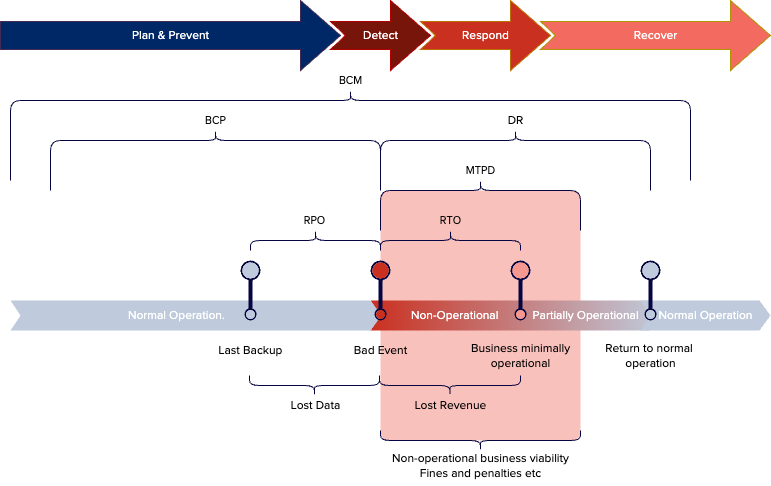Let's start with Business Continuity Planning (BCP) and Disaster Recovery (DR)!
Introduction
In today's digital landscape, businesses face an ever-increasing risk of cyber threats that can disrupt operations, compromise sensitive data, and damage reputations. It is crucial for organisations to prioritise cybersecurity and develop robust strategies to enhance business resilience. This first article in the series provides valuable insights into proactive measures to take before a cybersecurity incident and essential steps to follow in the aftermath, ensuring that your business remains secure and resilient.
Background and Terminology
The confusion surrounding Business Continuity Planning (BCP) and Disaster Recovery (DR) can arise due to several factors:
- Overlapping Terminology: BCP and DR are related concepts that share some similarities and are often used interchangeably or inconsistently in different organisations or industries. This inconsistent usage can lead to confusion and a lack of clear understanding of their distinct purposes.
- Varying Definitions: Different organisations and professionals may have varying definitions and interpretations of BCP and DR, further contributing to the confusion. There is no universally accepted standard definition for these terms, leading to discrepancies in their understanding and implementation.
- Evolving Nature of Technology and Risks: Technology advancements, evolving cyber threats, and changes in business environments have added complexity to the concepts of BCP and DR. The traditional boundaries between BCP and DR have become blurred as technology plays a critical role in both aspects. This dynamic landscape can make it challenging to define and differentiate BCP and DR clearly.
- Organisational Differences: BCP and DR practices can vary across organisations based on their size, industry, regulatory requirements, and specific operational needs. This variability contributes to differing interpretations and approaches to BCP and DR, leading to confusion when attempting to compare practices across different organisations.
- Integration and Convergence: In recent years, there has been a trend towards integrating BCP and DR practices into a holistic approach, often referred to as Business Continuity and Disaster Recovery (BCDR) or Business Resilience. This integration aims to address the interdependencies between business operations, IT systems, and data recovery more comprehensively. The evolving terminology and frameworks can add to the confusion as organisations adapt to these evolving practices.
To mitigate the confusion, it is important for organisations to clearly define and communicate their understanding of BCP and DR, aligning with industry standards and best practices. Organisations should also document their specific definitions, objectives, and processes for BCP and DR, fostering clarity and consistency within their own contexts. Regular education, training, and awareness programs can also help ensure that employees and stakeholders have a clear understanding of BCP and DR concepts and their respective roles in achieving organisational resilience.
So everyone is on the same page we will use the following diagram and terminology throughout this article,

| Term | Definition |
| BCM(S) | Business Continuity Management (System) - Governance of the whole process, including before, during and after |
| BCP | Business Continuity Planning - Pre-planning what to do if something does go wrong. |
| DR | Disaster Recovery - Performing the technical recovery and communication capabilities and actions. |
| MTPD | Maximum Tolerable Period of Disruption - How long can the business afford to be non-functional? (lost revenue, fines, reputation etc) also known as Maximum Allowable Outage or MAO |
| RTO | Recovery Time Objective - Target time frame for minimal recovery if the worst does happen. (usually represents lost operating revenue) |
| RPO | Recovery Point Objective - Maximum target data or operational information lost. (often represents lost data) |
It’s important to understand what happens before an incident occurs and what happens after…
BCP happens before something goes wrong, DR happens after and a BCM(S) provides overarching governance and management of both.
What is Business Continuity Planning (BCP)?
In the context of cybersecurity and business resilience, BCP stands for Business Continuity Planning. BCP refers to the process of developing a proactive and comprehensive plan to ensure the continued operation of critical business functions and processes in the event of a disruption, including cyber attacks.
Business Continuity Planning involves identifying potential risks and vulnerabilities, assessing their potential impact on the organisation, and developing strategies to mitigate those risks and maintain essential operations. The goal of BCP is to minimise downtime, recover critical functions efficiently, and limit financial and reputational damages.
Key components of Business Continuity Planning include:
- Risk Assessment and Business Impact Analysis (BIA): Identify and assess potential threats and risks that can disrupt business operations, including cyber threats. This involves understanding the potential impact of disruptions on critical processes, systems, and resources.
- Business Continuity Strategies: Develop strategies and solutions to ensure the continuity of critical business functions and processes during an incident. This may include backup systems, redundant infrastructure, alternative work locations, and contingency plans for key resources.
- Incident Response and Recovery Planning: Establish procedures and protocols to respond effectively to incidents and initiate recovery efforts. This includes defining roles and responsibilities, establishing communication channels, and outlining steps for containment, mitigation, and restoration.
- Communication and Stakeholder Management: Develop communication plans to ensure timely and accurate information dissemination to internal and external stakeholders during an incident. This includes employees, customers, partners, suppliers, regulatory bodies, and other relevant parties.
- Testing, Training, and Exercising: Regularly test and validate the effectiveness of the BCP through simulation exercises and drills. This helps identify gaps, improve response capabilities, and ensure that employees are familiar with their roles and responsibilities.
- Continuous Improvement: Review and update the BCP regularly based on lessons learned from incidents, changes in the business environment, and evolving cyber threats. This ensures that the plan remains up to date and aligned with the organisation’s evolving needs.
By implementing a robust Business Continuity Plan, organisations can minimize the impact of cyber incidents and other disruptions on their operations. BCP provides a structured approach to ensure the availability of critical functions, protect valuable assets, and maintain the trust of stakeholders, even in the face of cybersecurity challenges.
What is Disaster Recovery (DR)?
In the context of cybersecurity and business resilience, DR stands for Disaster Recovery. Disaster Recovery refers to the processes, strategies, and plans put in place to restore and recover critical IT systems, data, and infrastructure after a disruptive event, such as a cyber attack, natural disaster, or system failure.
The primary goal of Disaster Recovery is to minimise downtime, recover data and systems efficiently, and resume normal business operations as quickly as possible following a disruptive incident. DR focuses on the technical aspects of recovery, specifically addressing IT systems and infrastructure.
Key components of Disaster Recovery include:
- Business Impact Analysis (BIA): Assess the potential impact of a disruptive incident on critical IT systems and data. Identify the recovery time objectives (RTOs) and recovery point objectives (RPOs) for each system, which define the acceptable duration of downtime and the acceptable data loss.
- Backup and Data Replication: Implement regular backups of critical data and systems. Backups should be stored securely and offsite to protect against physical damage or loss. Additionally, data replication can be used to create real-time or near-real-time copies of data to enable quick recovery.
- Recovery Strategies: Define the recovery strategies and techniques to be used for different systems and scenarios. This may include techniques such as full system restores, bare-metal recovery, or virtual machine replication. Determine the order of recovery and priorities systems based on their criticality to the business.
- Recovery Plan Documentation: Develop detailed recovery plans outlining step-by-step procedures for recovering IT systems and infrastructure. These plans should include roles and responsibilities, contact information, necessary resources, and clear instructions for executing the recovery process.
- Testing and Validation: Regularly test and validate the effectiveness of the DR plan through simulated exercises and drills. This helps identify any gaps or weaknesses in the plan and ensures that recovery procedures are up to date and well understood by the relevant personnel.
- Continuous Improvement: Review and update the DR plan on a regular basis to incorporate lessons learned from testing, changes in the IT environment, and evolving cyber threats. This ensures that the plan remains effective and aligned with the organisation’s evolving needs.
By implementing a robust Disaster Recovery plan, organisations can minimise the impact of a cyber attack or other disruptive incidents on their IT systems and data. Effective DR capabilities enable rapid recovery, reduce downtime, and ensure business continuity, safeguarding the organisation’s operations, reputation, and customer trust.
BCP and DR Working Together
Business Continuity Planning (BCP) and Disaster Recovery (DR) are closely related and often work together to ensure the resilience of an organisation’s operations, particularly in the context of cybersecurity incidents. While they have distinct focuses, they are interdependent and contribute to an organisation’s overall ability to respond to and recover from disruptive events.
BCP focuses on the broader aspects of maintaining the continuity of critical business functions and processes during and after a disruption. It encompasses strategic planning, risk assessment, business impact analysis, communication plans, and incident response procedures. BCP ensures that the organisation can continue operating and delivering essential services even in the face of various incidents, including cyber attacks.
On the other hand, DR specifically focuses on the recovery of IT systems, infrastructure, and data following a disruptive event. It addresses technical aspects such as data backup, replication, system restoration, and recovery procedures. DR ensures that the organisation’s IT resources can be restored and made operational within defined recovery time objectives (RTOs) and recovery point objectives (RPOs).
The relationship between BCP and DR can be summarised as follows:
- BCP informs DR: Business Continuity Planning helps identify critical IT systems, data, and infrastructure that require priority in the recovery process. The business impact analysis conducted as part of BCP helps determine the RTOs and RPOs for different systems, guiding the development of the DR plan.
- DR supports BCP execution: During a disruptive event, the DR plan provides the technical procedures and guidelines necessary to restore IT systems and infrastructure. This enables the organisation to execute its overall business continuity strategy, ensuring the resumption of critical functions within the defined recovery timeframes.
- Collaboration and coordination: BCP and DR teams collaborate closely to align their efforts and ensure a comprehensive response to incidents. BCP provides the overarching framework and incident response protocols, while DR provides the technical expertise to recover IT systems. Coordination between the two ensures a cohesive and efficient response and recovery process.
- Testing and validation: BCP and DR plans should be regularly tested through simulation exercises to ensure their effectiveness. Testing scenarios may include cyber attack simulations, where both BCP and DR plans are put into action to evaluate their combined response and recovery capabilities.
Conclusion
Ultimately, BCP and DR work together to ensure the organisation’s resilience in the face of disruptive events, including cyber attacks. BCP focuses on maintaining critical business functions, while DR focuses on recovering IT systems and data. By integrating BCP and DR efforts, organisations can enhance their overall preparedness, response, and recovery capabilities, minimising the impact of incidents and ensuring business continuity.
To be continued (in part 2)…
Contact us today to explore how our specialist cybersecurity consulting services can assist you in assessing business resilience, establishing a strong cybersecurity baseline, and advancing your organisation's cyber defence maturity. Together, we can elevate your cybersecurity posture to safeguard your critical assets, data, and operations from ever-evolving cyber threats.

August 7, 2023